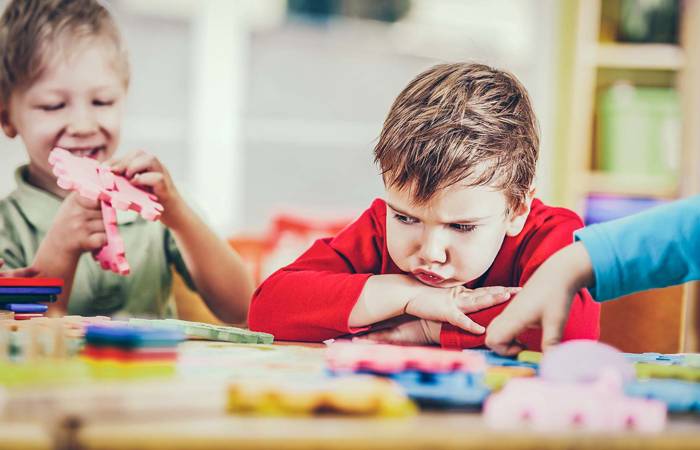Like what you see?
Sign up to receive more free parenting advice.
Thank you for subscribing to our newsletter!
Child Development

Credit: iStock.com/MMPhotography
When parents are faced with a child experiencing strong emotions – anger, frustration or sadness, it’s easy to default to the question: “Why is this upsetting you so much?”.
But as one of Australia’s leading experts on emotions in young children points out, “Why?” is unlikely to help our child.
“As an adult the ‘why’ is hard to answer and children usually don’t know, especially when they are in an emotion. ‘Why’ appeals to their rational thinking, which they often don’t have access to at that time,” says child clinical psychologist and Associate Professor from the University of Melbourne, Dr Sophie Havighurst.
Instead, she suggests that when a child is emotional, parents of young children do very little talking.
“That’s because the thing that actually emotionally calms a child is connection. In fact, that’s the function of emotions, to bring your caregiver and attachment figures closer so that you can calm down. After that, you can think it through and work out what to do,” says Dr Havighurst.
Dr Havighurst and educator Ann Harley are co-authors of a parenting program called Tuning in to Kids. Developed in 1999, the pair believed it was important parents had access to a program that wasn’t focused on simply controlling children’s behaviour.
Today, about 8500 professionals, mostly in Australia, have now been taught how to help families using the Tuning in to Kids, Tuning in to Teens and Dads and Tuning in to Kids programs.
“We wanted parents to be able to respond to their children’s anger, their sadness, their disappointment, their frustration, and to teach kids about those emotional experiences within the context of that connected relationship between the parent and the child,” says Dr Havighurst.
You need to stay with them without lots of talking. Stop the explanation, stop the questions. Instead say, ‘It’s hard’, or ‘How frustrating’, or ‘How disappointing’, or ‘Yes, you really missed me’. We are aiming to reflect their feeling and keep that attachment connection.Dr Sophie Havighurst
Stay up to date with the latest news and articles from First Five Years
Thank you for subscribing to our newsletter!
What helps children work through strong emotions?
Helping our children calm themselves helps them to understand their emotions, and to ultimately learn to solve their own problems as they get older.
Calming a young child might take the form of a hug, or a gentle touch.
“You might come closer to them and hold them or pick them up and scoop them away and just pat their back, or say, ‘Just come over here for a bit’. You help them to calm before you try and explore what’s going on,” Dr Havighurst says.
The talking, when it comes, might simply be validation of your child’s situation. Dr Havighurst suggests a parent could say: “Gosh, that’s hard – I know you really wanted to keep playing with that toy” or “That’s a really tricky situation you are in”.
“That validation helps you feel like your parent or the person you're talking to has got your back; that they're behind you and they accept your feelings. As adults, when that happens there’s something that shifts inside of us. It’s like, ‘Okay. How I am feeling right now is legitimate’. That’s exactly what happens with kids as well,” Dr Havighurst says.
Helping our children name their emotion
When calm is restored, parents can help their children by teaching them to name the emotion they have been feeling.
“You need to stay with them without lots of talking. Stop the explanation, stop the questions. Instead say, ‘It’s hard’, or ‘How frustrating’, or ‘How disappointing’, or ‘Yes, you really missed me’. We are aiming to reflect their feeling and keep that attachment connection,” Dr Havighurst says.
Of course, sometimes, solutions are necessary.
“But often, we jump to giving the solution way too early when the child is still quite emotional and that often leads to the wrong outcome. They have a further tantrum and shut down. It doesn’t work. It’s once the emotion has reduced that they can start thinking. So it’s then you might say, ‘I wonder what would help here?’,” Dr Havighurst says.
Controlling our own emotions as parents
It can be hard for parents to keep their own emotions in check when faced with a young child who is angry, upset or frustrated.
Dr Havighurst offers two important tips here. The first is recognising that as parents, we need to look after our own self-care.
“Selfcare is the nutrition you need to be able to be more patient and more emotionally responsive. When you're all worn out, you can't do that,” she says.
The second tip for parents who are feeling emotional is to build in a pause of 30 seconds before reacting.
“When you are emotionally activated that’s when you flip into your automatic reactions to the child’s emotion which are often more dismissive, harsh or rejecting. To create the pause you could count to ten; go to the toilet; have a big cold drink of water that cools your arousal system, suck on some ice, step outside for a moment, or even just rub your hands together with a cream,” she says.
Tuning in to Toddlers
Dr Havighurst, Ann and Dr Christiane Kehoe recently finished running a trial of Tuning in to Kids specifically aimed at 18 to 36-month-old children. She says Tuning in to Toddlers uses the same principles as for older children, but the use of language is reduced even further. Instead, body language helps toddlers to learn about emotional states.
“You would just say, “Oh, sad” and reflect the emotion using facial expression, body language and tone of voice. Kids don’t always have a lot of language when they are very young, but they respond to your body language: that’s how they learn,” she says.
Understanding how to be an ‘emotion coach’ for your child.
Thanks to Dr Havighurst and Ann Harley for the following advice from the Tuning in to Kids course, based on the work of John Gottman and colleagues’ work on emotion coaching.
To be an emotion coach for your child you:
• Become aware of emotions, especially when they are lower intensity emotions like disappointment or frustration.
• Be present: View your child’s emotion as an opportunity for emotional connection and teaching.
• Communicate your understanding and acceptance of an emotion using words, tone and body language.
• Name the feeling.
• If necessary, you might then give comfort, provide distraction, redirect, assist with choices, help to problem solve or set limits.







